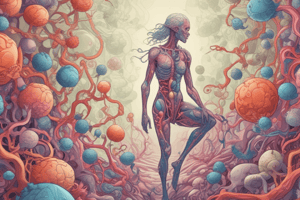Podcast
Questions and Answers
¿Qué permite a las células interactuar entre sí utilizando hormonas, neurotransmisores y otras moléculas señalizadoras?
¿Qué permite a las células interactuar entre sí utilizando hormonas, neurotransmisores y otras moléculas señalizadoras?
- La morfología bilateral
- La simetría multicelular
- La biología embrionaria
- La comunicación celular (correct)
¿Qué etapa del desarrollo humano involucra procesos como la división celular, la formación de tejidos y la organogénesis?
¿Qué etapa del desarrollo humano involucra procesos como la división celular, la formación de tejidos y la organogénesis?
- El crecimiento físico
- El desarrollo embrionario (correct)
- La biología celular
- La morfogénesis
¿Cuál es una característica distintiva de los humanos en términos de morfología?
¿Cuál es una característica distintiva de los humanos en términos de morfología?
- Morfología asimétrica
- Simetría radial
- Unicelularidad
- Simetría bilateral (correct)
¿Qué aspecto de la anatomía humana se refiere al estudio de la organización estructural del cuerpo y sus componentes?
¿Qué aspecto de la anatomía humana se refiere al estudio de la organización estructural del cuerpo y sus componentes?
¿En qué se enfoca la biología celular en relación con los procesos fisiológicos normales y condiciones patológicas?
¿En qué se enfoca la biología celular en relación con los procesos fisiológicos normales y condiciones patológicas?
¿Qué sistema del cuerpo humano es responsable del transporte de oxígeno y nutrientes a las células y la eliminación de desechos metabólicos?
¿Qué sistema del cuerpo humano es responsable del transporte de oxígeno y nutrientes a las células y la eliminación de desechos metabólicos?
¿Cuál es la función principal de las células en los organismos vivos?
¿Cuál es la función principal de las células en los organismos vivos?
¿Cuál de las siguientes afirmaciones es correcta sobre la división celular?
¿Cuál de las siguientes afirmaciones es correcta sobre la división celular?
¿Cuál de las siguientes afirmaciones es correcta sobre la información genética en las células?
¿Cuál de las siguientes afirmaciones es correcta sobre la información genética en las células?
¿Cuál de las siguientes afirmaciones describe mejor la biología celular?
¿Cuál de las siguientes afirmaciones describe mejor la biología celular?
¿Qué papel desempeñan los orgánulos en las células?
¿Qué papel desempeñan los orgánulos en las células?
¿Por qué es importante comprender los procesos celulares en relación con la salud y las enfermedades?
¿Por qué es importante comprender los procesos celulares en relación con la salud y las enfermedades?
Flashcards are hidden until you start studying
Study Notes
Biology: Exploring Cell Biology and Human Anatomy
Biology is a vast field that encompasses various aspects of living organisms, including their physical characteristics, behavior, origin, evolution, distribution, and interactions with the environment. It's divided into several subfields, two of which are particularly relevant to our discussion: cell biology and human anatomy.
Cell Biology
Cell biology deals with the structure, function, and interactions of cells, which are the fundamental units of life. They serve as the building blocks of tissues, organs, and organ systems. Understanding cellular processes is crucial because it provides insights into health and disease states. Some key concepts in cell biology include:
- Cell Structure: Cells consist of organelles like mitochondria, ribosomes, endoplasmic reticulum, Golgi apparatus, and nucleus, among others. Each organelle has a unique role in maintaining cellular functions.
- Cell Division: This is the process by which a single cell divides into two daughter cells during growth or repair. Mitosis and meiosis are two types of cell division, with mitosis producing identical daughter cells and meiosis creating sexally diverse cells.
- Genetic Information: DNA carries genetic information within cells and plays a central role in determining traits passed down through generations.
- Cellular Communication: Cells interact with each other using hormones, neurotransmitters, and other signaling molecules, allowing for coordinated responses to internal and external stimuli.
Human Anatomy
Human anatomy refers to the study of the body's structural organization, including its components and their interrelationships. Key aspects of human anatomy include:
- Organ Systems: The human body consists of several organ systems, each performing specific functions related to survival and maintenance. Examples include the circulatory system, respiratory system, nervous system, digestive system, and integumentary system.
- Physical Features: Humans possess distinct morphological features, such as bilateral symmetry, multicellularity, and specialized tissues adapted for different purposes.
- Embryonic Development: Human development starts from a fertilized egg and goes through various stages leading to a mature individual, involving processes like cell division, tissue formation, and organogenesis.
Both cell biology and human anatomy are essential parts of biology, with each shedding light on different aspects of life. By studying these subfields, we can better understand the intricate mechanisms underlying both normal physiological processes and pathological conditions.
Studying That Suits You
Use AI to generate personalized quizzes and flashcards to suit your learning preferences.




